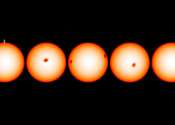New method to detect Tatooine-like planets validated
A new technique developed in part by University of Hawaiʻi astronomer Nader Haghighipour has allowed scientists to quickly detect a transiting planet with two suns.

A new technique developed in part by University of Hawaiʻi astronomer Nader Haghighipour has allowed scientists to quickly detect a transiting planet with two suns.
Astronomy
Nov 10, 2021
0
1474

Astronomers searching for Earth-like planets in other solar systems have made a breakthrough by taking a closer look at the surface of stars.
Astronomy
Oct 26, 2021
0
271

An international team of astronomers led by scientists from Leiden University has for the first time characterized a dust disk surrounding a young super-Jupiter, which is either a giant planet or brown dwarf. They used so-called ...
Astronomy
Oct 13, 2021
0
38

An international team of astronomers has unveiled the nature of hundreds of gamma-ray emitting sources, discovering that most of them belong to the class of active galaxies known as blazars.
Astronomy
Oct 11, 2021
0
1341

Astronomers from National Astronomical Observatories of Chinese Academy of Sciences (NAOC), Shanghai Astronomical Observatory of CAS and Nanjing University have revealed the wobbly and flared nature of the Milky Way disk ...
Astronomy
Sep 30, 2021
1
354

When the world's most powerful telescope launches into space this year, scientists will learn whether Earth-sized planets in our 'solar neighborhood' have a key prerequisite for life—an atmosphere.
Astronomy
Sep 29, 2021
1
198

A group of astronomers from the Astrobiology Center, the National Astronomical Observatory of Japan, the University of Tokyo, and other institutes, discovered two rocky super-Earth exoplanets lacking thick primordial atmospheres ...
Astronomy
Sep 27, 2021
0
3656

The night sky is going to get much busier thanks to thousands of new internet satellites set to launch over the next few years—and researchers say it's going to affect Canada more than most places on Earth.
Space Exploration
Sep 21, 2021
2
604

Finding an exact copy of the Earth somewhere in the universe sounds like a far-fetched notion, but scientists believe that because Earth happened in our solar system, something similar is bound to exist someplace else. University ...
Astronomy
Sep 9, 2021
0
180

It's suspected that about 5,000 years ago a comet may swept within 23 million miles of the Sun, closer than the innermost planet Mercury. The comet might have been a spectacular sight to civilizations across Eurasia and North ...
Astronomy
Aug 19, 2021
1
1255